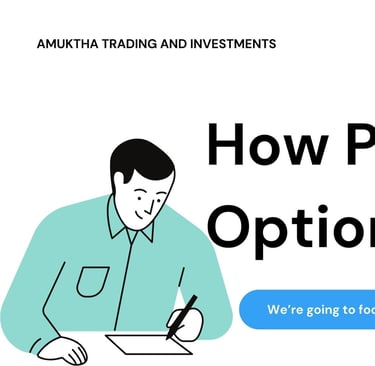How Put Options Work
Put options are a type of financial derivative that give investors and traders the right, but not the obligation, to sell an underlying asset at a specified price (the strike price) before or at the expiration date. Here’s a detailed explanation of how put options work:
1. Put Options Basic Definition
A put option grants the holder the right to sell the underlying asset at the strike price on or before the option’s expiration date.
2. Components of a Put Option
Strike Price: The price at which you can sell the underlying asset.
Expiration Date: The date by which you must exercise the option if you choose to do so.
Premium: The cost of purchasing the put option, paid upfront.
3. How Put Options Work
Buying a Put Option
Initiating the Purchase: When you buy a put option, you pay a premium to acquire the right to sell the underlying asset at the strike price.
Expectation: You typically buy a put option if you expect the price of the underlying asset to fall below the strike price before the option expires.
Example: Suppose you buy a put option on Company XYZ stock with a strike price of $50 and an expiration date one month from now. If the current stock price is $55, and you pay a premium of $3 for the option, you’re betting that XYZ’s stock price will decrease.
Exercising the Option
Decision Point: If the price of the underlying asset falls below the strike price, you can exercise the option to sell the asset at the higher strike price. This could lead to a profit if the asset’s market price is significantly lower than the strike price.
Example: If XYZ’s stock price drops to $40, you can exercise the option and sell the stock at $50, then potentially buy it back at the market price of $40, realizing a profit. Subtract the premium paid from this profit to get your net gain.
Selling the Option
Alternative to Exercising: Instead of exercising the option, you can sell the put option itself if it has increased in value. This can be a way to profit from the price drop of the underlying asset without having to sell the asset itself.
Example: If XYZ’s stock price falls and the value of your put option rises to $12, you could sell the option for a profit, assuming you paid $3 initially. Your profit in this case would be the selling price minus the premium paid, or $12 - $3 = $9 per share.
Letting the Option Expire
Out-of-the-Money: If the price of the underlying asset does not fall below the strike price before the expiration date, the put option will expire worthless. In this case, you lose the premium paid for the option.
Example: If XYZ’s stock price remains above $50, the option is not exercised, and you lose the $3 premium paid.
4. Profit and Loss
Profit Potential: The potential profit from a put option can be significant but is capped because the underlying asset’s price can only fall to zero. Your profit is the difference between the strike price and the asset’s market price, minus the premium paid.
Loss Potential: The maximum loss is limited to the premium paid for the option. If the option expires worthless, you lose the premium.
5. Factors Affecting Put Option Prices
Several factors influence the price (premium) of a put option, including:
Underlying Asset Price: The lower the asset price relative to the strike price, the more valuable the put option generally is.
Strike Price: Put options with a higher strike price relative to the underlying asset’s price typically have higher premiums.
Time Until Expiration: Options with longer expiration periods generally have higher premiums because they offer more time for the asset’s price to move favorably.
Volatility: Higher volatility in the underlying asset’s price can increase the option’s premium, as there is a greater chance of significant price movement.
Interest Rates: Higher interest rates can slightly decrease put option premiums because the cost of holding the underlying asset is factored in.
6. Using Put Options in Strategies
Put options can be part of various trading and investment strategies:
Protective Put: Buying a put option to protect against a decline in the price of an asset you own. This is a form of insurance.
Long Put: Buying a put option with the expectation that the asset’s price will decline, allowing you to profit from the drop.
Put Spread: Buying and selling put options with different strike prices to limit risk and cost.
Naked Put: Selling put options without holding the underlying asset, betting that the asset’s price will not fall below the strike price.
Conclusion
Put options offer a way to profit from a decline in the price of an underlying asset or to hedge against potential losses in an existing investment. Understanding how they work, along with their potential benefits and risks, is crucial for using put options effectively in your trading or investment strategy.


Disclaimer:- Trading and Investments in the securities market are subject to market risk, and read all the related documents carefully before investing. The content is for informational purposes only and should not be construed as investment advice. Always consult with a qualified financial professional before making any trading decisions.
